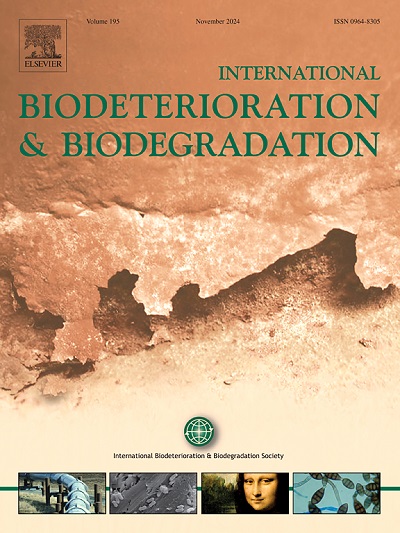Sulfadiazine degradation by Acinetobacter sp. strain H-3 and its applicability in soil at low temperatures
IF 4.1
2区 环境科学与生态学
Q2 BIOTECHNOLOGY & APPLIED MICROBIOLOGY
International Biodeterioration & Biodegradation
Pub Date : 2025-02-01
DOI:10.1016/j.ibiod.2025.105998
引用次数: 0
Abstract
The prolonged and widespread use of veterinary antibiotics resulted in a significant accumulation of antibiotic residues in the soil surrounding poultry farms, thereby promoting the proliferation and dissemination of antibiotic resistance genes (ARGs) and antibiotic-resistant bacteria (ARB). In the northern regions of China, low temperatures hinder the microbial degradation of antibiotics. This study reports that Acinetobacter sp. H-3, isolated from a poultry farm in Liaoning Province, Northeast China, is capable of effectively degrading SDZ at a minimum temperature of 5°C, with optimal degradation efficiency observed at 15°C. The strain H-3 removed 82% of SDZ from the soil over a 14-day period at 15°C, with 53% of this degradation directly attributed to the activity of strain H-3. High-throughput sequencing and RT-qPCR analyses revealed that exposure to SDZ significantly altered the soil bacterial community structure, inhibited soil microbial functions and increased the abundance of sul1, sul2 and intI1 genes. Following the application of, certain bacterial genera in the contaminated soil exhibited indications of recovery. However, the overall soil microbial function did not show a recovery trend. Additionally, the presence of strain H-3, which carries the sul1, sul2 and intI1 genes, resulted in an increase in sul1, followed by a subsequent decrease, while the levels of sul2 and intI1 continued to rise. This study is the first to report that Acinetobacter sp. strain H-3 can effectively remove SDZ at low temperatures. Furthermore, it provides a preliminary evaluation of the ecological risks linked to the dissemination of ARGs during the application of this strain, contributing valuable resources and theoretical insights for the bioremediation of antibiotic-polluted soil in cold areas.

不动杆菌H-3对磺胺嘧啶的降解及其在土壤中的低温适用性
兽医抗生素的长期和广泛使用导致家禽养殖场周围土壤中抗生素残留的大量积累,从而促进抗生素耐药基因(ARGs)和抗生素耐药细菌(ARB)的增殖和传播。在中国北方地区,低温阻碍了抗生素的微生物降解。本研究报道了从中国东北辽宁省某家禽养殖场分离到的不动杆菌sp. H-3在最低温度为5°C时能够有效降解SDZ,在15°C时降解效率最高。菌株H-3在15°C条件下,在14天的时间内去除土壤中82%的SDZ,其中53%的降解直接归因于菌株H-3的活性。高通量测序和RT-qPCR分析显示,SDZ暴露显著改变了土壤细菌群落结构,抑制了土壤微生物功能,增加了sul1、sul2和intI1基因的丰度。施用后,污染土壤中的某些细菌属表现出恢复的迹象。土壤微生物功能总体未呈现恢复趋势。此外,携带sul1、sul2和intI1基因的菌株H-3的存在导致sul1先升高后降低,而sul2和intI1的水平则持续升高。本研究首次报道了H-3不动杆菌可以在低温下有效去除SDZ。此外,该研究还初步评估了该菌株在应用过程中与ARGs传播相关的生态风险,为寒冷地区抗生素污染土壤的生物修复提供了宝贵的资源和理论见解。
本文章由计算机程序翻译,如有差异,请以英文原文为准。
求助全文
约1分钟内获得全文
求助全文
来源期刊
CiteScore
9.60
自引率
10.40%
发文量
107
审稿时长
21 days
期刊介绍:
International Biodeterioration and Biodegradation publishes original research papers and reviews on the biological causes of deterioration or degradation.

 求助内容:
求助内容: 应助结果提醒方式:
应助结果提醒方式:


